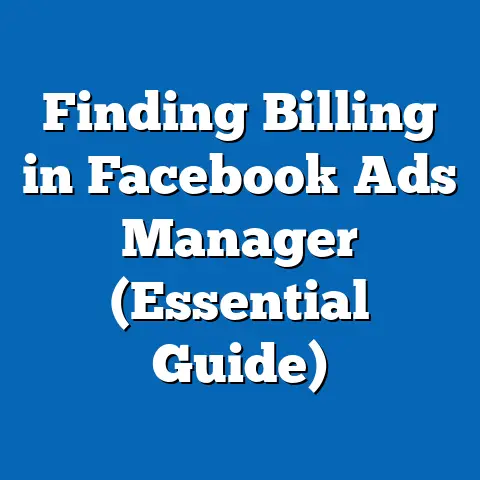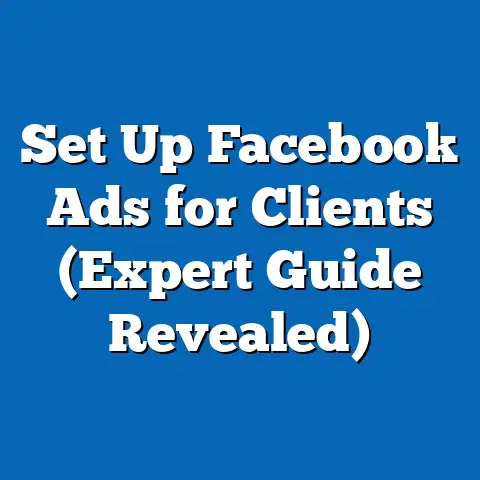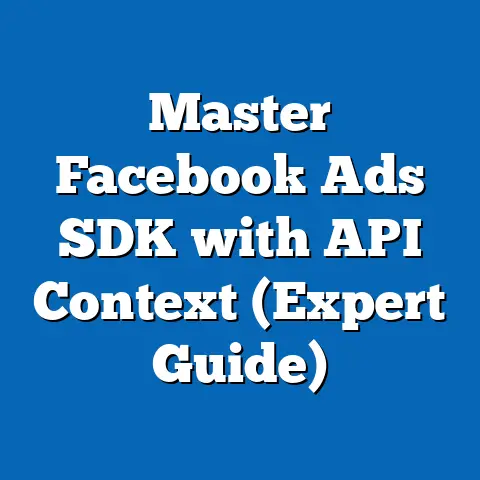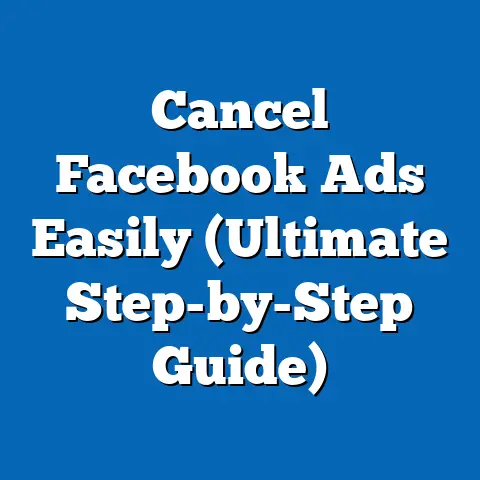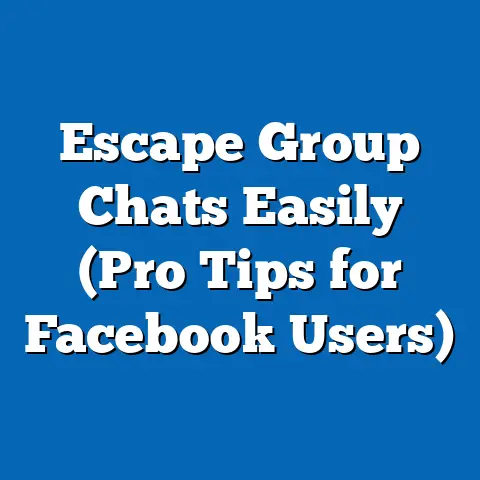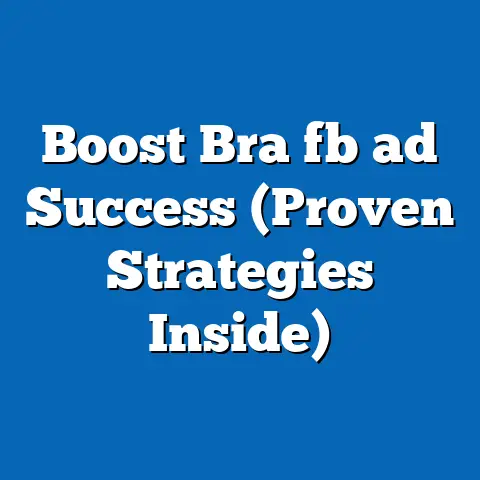Fund Facebook Ads Account (Smart Strategies Revealed)
The digital marketing landscape is a relentless race. Businesses are scrambling for attention, vying for clicks, and desperately seeking conversions. In this high-stakes game, a robust Facebook advertising strategy isn’t just an advantage—it’s a necessity. Yet, many businesses stumble, not from a lack of creativity or compelling offers, but from a fundamental misunderstanding: how to effectively fund their Facebook Ads account. I’ve seen firsthand how a well-funded, strategically managed campaign can catapult a small business to new heights, while a poorly funded one can drain resources and leave you wondering if Facebook ads even work.
We’re not talking about simply throwing money at Facebook and hoping for the best. It’s about understanding the intricacies of the platform, setting realistic budgets, and employing smart strategies to maximize your return on ad spend (ROAS). In today’s hyper-competitive market, you can’t afford to fall behind. According to Statista, global digital ad spending is projected to reach \$626.86 billion in 2024, demonstrating the sheer magnitude of investment being poured into online advertising.
This article isn’t just another guide; it’s your roadmap to mastering Facebook Ads funding. I’ll walk you through the essentials, from understanding the billing system to implementing advanced optimization techniques. We’ll explore real-world examples, dissect successful campaigns, and arm you with the knowledge to make data-driven decisions. Prepare to unlock the full potential of your Facebook advertising efforts and transform your marketing ROI. Let’s dive in!
Understanding Facebook Ads Funding
Before we delve into the strategies, let’s solidify our understanding of what it truly means to fund a Facebook Ads account. It’s more than just linking a credit card; it’s the lifeblood of your advertising campaigns. Without sufficient funding, your ads won’t run, your target audience won’t see your message, and your business goals will remain out of reach.
At its core, funding a Facebook Ads account involves allocating monetary resources to pay for the ads you run on the platform. This funding covers the costs associated with displaying your ads to your target audience, including impressions (the number of times your ad is shown), clicks (the number of times people click on your ad), and conversions (the number of desired actions taken as a result of your ad, such as purchases or sign-ups).
How the Facebook Ads Billing System Works
Facebook’s billing system operates on a postpay model, meaning you accrue advertising costs and are then billed periodically. Here’s a breakdown of the key components:
-
Payment Methods: Facebook accepts a variety of payment methods, including:
- Credit cards (Visa, Mastercard, American Express, Discover)
- Debit cards
- PayPal
- Local payment methods (depending on your region)
I always recommend using a credit card that offers rewards points or cashback, as this can provide a small but tangible return on your advertising spend.
-
Billing Threshold: Facebook sets a billing threshold for your account, which is the amount you can spend on ads before being charged. This threshold typically starts low and increases as you consistently pay your bills on time. For example, your initial threshold might be \$25, and it could gradually increase to \$50, \$250, and so on.
-
Billing Cycle: Facebook bills you whenever you reach your billing threshold or at the end of the month, whichever comes first. So, if your billing threshold is \$25 and you spend \$25 on ads within a week, you’ll be billed \$25 at that point. If you don’t reach your threshold by the end of the month, you’ll be billed for the total amount spent during that month.
-
Automatic vs. Manual Payments: Facebook offers both automatic and manual payment options. With automatic payments, Facebook automatically charges your chosen payment method whenever you reach your billing threshold or at the end of the month. With manual payments, you add funds to your account balance in advance, and Facebook deducts ad costs from that balance.
I generally prefer automatic payments for their convenience, but manual payments can be useful for businesses that want tighter control over their spending or have specific budgeting requirements.
Payment Methods: Facebook accepts a variety of payment methods, including:
- Credit cards (Visa, Mastercard, American Express, Discover)
- Debit cards
- PayPal
- Local payment methods (depending on your region)
I always recommend using a credit card that offers rewards points or cashback, as this can provide a small but tangible return on your advertising spend.
Billing Threshold: Facebook sets a billing threshold for your account, which is the amount you can spend on ads before being charged. This threshold typically starts low and increases as you consistently pay your bills on time. For example, your initial threshold might be \$25, and it could gradually increase to \$50, \$250, and so on.
Billing Cycle: Facebook bills you whenever you reach your billing threshold or at the end of the month, whichever comes first. So, if your billing threshold is \$25 and you spend \$25 on ads within a week, you’ll be billed \$25 at that point. If you don’t reach your threshold by the end of the month, you’ll be billed for the total amount spent during that month.
Automatic vs. Manual Payments: Facebook offers both automatic and manual payment options. With automatic payments, Facebook automatically charges your chosen payment method whenever you reach your billing threshold or at the end of the month. With manual payments, you add funds to your account balance in advance, and Facebook deducts ad costs from that balance.
I generally prefer automatic payments for their convenience, but manual payments can be useful for businesses that want tighter control over their spending or have specific budgeting requirements.
The Impact of Funding Levels on Campaign Performance
The amount of funding you allocate to your Facebook Ads campaigns directly impacts their reach, frequency, and overall performance. A well-funded campaign can:
- Reach a Larger Audience: With a higher budget, you can target a wider audience, increasing the chances of finding potential customers.
- Increase Ad Frequency: More funding allows you to show your ads more frequently to your target audience, reinforcing your message and improving brand recall.
- Improve Ad Placement: Facebook’s algorithm prioritizes ads from advertisers who are willing to spend more, giving them better placement and visibility.
- Generate More Conversions: By reaching a larger audience and increasing ad frequency, you’re more likely to generate conversions, such as sales, leads, or sign-ups.
Conversely, a poorly funded campaign can suffer from:
- Limited Reach: Your ads may only be shown to a small segment of your target audience, limiting your potential impact.
- Low Ad Frequency: Your audience may not see your ads often enough to remember your brand or be persuaded to take action.
- Poor Ad Placement: Your ads may be relegated to less desirable placements, such as the right-hand column or the bottom of the news feed, where they’re less likely to be seen.
- Fewer Conversions: With limited reach, frequency, and placement, you’re less likely to generate the desired conversions.
According to a study by AdEspresso, businesses that invested more in their Facebook Ads campaigns saw a 32% increase in conversion rates compared to those with lower budgets.
Takeaway: Understanding the Facebook Ads billing system and the impact of funding levels on campaign performance is crucial for advertising success. Choose the right payment method, monitor your billing threshold, and allocate sufficient funding to reach your target audience and achieve your business goals.
Setting a Budget for Facebook Ads
Now that we understand the importance of funding, let’s delve into the art of setting a budget. This isn’t about pulling a number out of thin air; it’s a strategic process that requires careful consideration of your business goals, target audience, and industry benchmarks.
Determining an Appropriate Budget: A Step-by-Step Guide
-
Define Your Business Goals: What do you want to achieve with your Facebook Ads campaigns? Are you looking to increase brand awareness, generate leads, drive sales, or something else? Your goals will directly influence your budget. For example, a brand awareness campaign may require a lower budget than a lead generation campaign.
I always advise clients to start with clearly defined, measurable goals. “Increase website traffic” is too vague. “Increase website traffic by 20% in the next quarter” is much better.
-
Identify Your Target Audience: Who are you trying to reach with your ads? Understanding your target audience’s demographics, interests, and behaviors is crucial for effective targeting and budget allocation. The more specific your targeting, the more efficient your ad spend will be.
Use Facebook Audience Insights to gather data on your target audience. This tool provides valuable information about their demographics, interests, behaviors, and purchasing habits.
-
Research Industry Benchmarks: What are other businesses in your industry spending on Facebook Ads? Researching industry benchmarks can give you a sense of what’s considered a reasonable budget. Look for data on average cost-per-click (CPC), cost-per-impression (CPM), and conversion rates in your industry.
Companies like WordStream and HubSpot regularly publish data on industry benchmarks for Facebook Ads.
-
Consider Your Customer Lifetime Value (CLTV): How much revenue does a customer generate for your business over their lifetime? Understanding your CLTV can help you determine how much you’re willing to spend to acquire a new customer.
If your CLTV is \$500, you might be willing to spend up to \$100 to acquire a new customer through Facebook Ads.
-
Start Small and Test: Don’t feel pressured to allocate a huge budget right away. Start with a smaller budget and test different ad creatives, targeting options, and bidding strategies. Monitor your results closely and adjust your budget accordingly.
I recommend starting with a daily budget of \$5-\$10 per ad set and gradually increasing it as you see positive results.
-
Factor in Creative Costs: Remember to factor in the cost of creating your ad creatives, including images, videos, and ad copy. High-quality creatives can significantly improve your ad performance and justify a higher budget.
Consider hiring a professional designer or copywriter to create compelling ad creatives.
Define Your Business Goals: What do you want to achieve with your Facebook Ads campaigns? Are you looking to increase brand awareness, generate leads, drive sales, or something else? Your goals will directly influence your budget. For example, a brand awareness campaign may require a lower budget than a lead generation campaign.
I always advise clients to start with clearly defined, measurable goals. “Increase website traffic” is too vague. “Increase website traffic by 20% in the next quarter” is much better.
Identify Your Target Audience: Who are you trying to reach with your ads? Understanding your target audience’s demographics, interests, and behaviors is crucial for effective targeting and budget allocation. The more specific your targeting, the more efficient your ad spend will be.
Use Facebook Audience Insights to gather data on your target audience. This tool provides valuable information about their demographics, interests, behaviors, and purchasing habits.
Research Industry Benchmarks: What are other businesses in your industry spending on Facebook Ads? Researching industry benchmarks can give you a sense of what’s considered a reasonable budget. Look for data on average cost-per-click (CPC), cost-per-impression (CPM), and conversion rates in your industry.
Companies like WordStream and HubSpot regularly publish data on industry benchmarks for Facebook Ads.
Consider Your Customer Lifetime Value (CLTV): How much revenue does a customer generate for your business over their lifetime? Understanding your CLTV can help you determine how much you’re willing to spend to acquire a new customer.
If your CLTV is \$500, you might be willing to spend up to \$100 to acquire a new customer through Facebook Ads.
Start Small and Test: Don’t feel pressured to allocate a huge budget right away. Start with a smaller budget and test different ad creatives, targeting options, and bidding strategies. Monitor your results closely and adjust your budget accordingly.
I recommend starting with a daily budget of \$5-\$10 per ad set and gradually increasing it as you see positive results.
Factor in Creative Costs: Remember to factor in the cost of creating your ad creatives, including images, videos, and ad copy. High-quality creatives can significantly improve your ad performance and justify a higher budget.
Consider hiring a professional designer or copywriter to create compelling ad creatives.
Understanding CPC and CPM
Cost-per-click (CPC) and cost-per-impression (CPM) are two key metrics that influence your funding decisions.
- CPC (Cost-Per-Click): This is the amount you pay each time someone clicks on your ad. CPC is typically used for campaigns focused on driving traffic to your website or landing page.
- CPM (Cost-Per-Mille or Cost-Per-Thousand Impressions): This is the amount you pay for every 1,000 impressions your ad receives. CPM is typically used for campaigns focused on brand awareness or reaching a large audience.
The ideal CPC and CPM will vary depending on your industry, target audience, and ad quality. However, understanding these metrics can help you optimize your budget allocation.
For example, if you’re running a lead generation campaign and your CPC is high, you might consider refining your targeting or improving your ad copy to lower your CPC and get more clicks for your budget.
Case Study: Budget Allocation for a Successful Campaign
Let’s look at a real-world example of how a business successfully allocated its budget for a Facebook Ads campaign.
Business: A local bakery looking to increase sales of its custom cakes.
Goal: Generate 50 new cake orders in the next month.
Target Audience: Women aged 25-45 living within a 10-mile radius of the bakery, interested in baking, parties, and special occasions.
Budget: \$500
Budget Allocation:
- Ad Creatives: \$100 (professional photos of cakes and compelling ad copy)
- Campaign Setup and Management: \$100 (time spent setting up and managing the campaign)
- Ad Spend: \$300 (allocated to running the ads)
Results:
- The bakery generated 60 new cake orders, exceeding its goal.
- The average cost per order was \$5.
Takeaway: By carefully defining its goals, identifying its target audience, and allocating its budget strategically, the bakery was able to achieve a high ROI on its Facebook Ads campaign.
Takeaway: Setting a budget for Facebook Ads requires careful planning and consideration of your business goals, target audience, and industry benchmarks. Start small, test different strategies, and monitor your results closely to optimize your budget allocation and achieve your desired outcomes.
Smart Strategies for Funding Your Facebook Ads Account
Now, let’s get into the actionable strategies. Funding your Facebook Ads account isn’t just about setting a budget; it’s about maximizing the impact of every dollar you spend. These strategies will help you do just that.
4.1 Leverage Audience Insights
One of the most powerful tools in your Facebook advertising arsenal is Audience Insights. This free tool provides a wealth of data about your target audience, allowing you to refine your targeting and maximize your ROAS. I’ve seen campaigns transformed simply by implementing insights gleaned from this tool.
How to Use Audience Insights:
- Access Audience Insights: Go to Facebook Ads Manager and navigate to “Audience Insights.”
- Select Your Audience: Choose whether to analyze everyone on Facebook or people connected to your page.
- Define Your Criteria: Enter your target audience’s demographics, interests, and behaviors.
- Analyze the Data: Explore the data provided by Audience Insights, including:
- Demographics: Age, gender, education, relationship status, job titles, and location.
- Interests: Pages they like, topics they’re interested in, and activities they engage in.
- Behaviors: Purchase behavior, device usage, and travel habits.
- Page Likes: Top pages they like, providing insights into their interests and preferences.
- Location: Where they live, work, and travel.
- Activity: How often they use Facebook and what types of content they engage with.
- Demographics: Age, gender, education, relationship status, job titles, and location.
- Interests: Pages they like, topics they’re interested in, and activities they engage in.
- Behaviors: Purchase behavior, device usage, and travel habits.
- Page Likes: Top pages they like, providing insights into their interests and preferences.
- Location: Where they live, work, and travel.
- Activity: How often they use Facebook and what types of content they engage with.
Example:
Let’s say you’re selling organic skincare products and targeting women aged 25-45 interested in beauty, health, and wellness. Audience Insights might reveal that your target audience is also interested in yoga, meditation, and sustainable living. You can then use this information to refine your targeting and create ads that resonate with their values and interests.
Maximizing ROAS:
By using Audience Insights to understand your target audience’s preferences, you can:
- Refine Your Targeting: Target your ads to the most relevant audience segments, increasing the chances of engagement and conversions.
- Create Compelling Ad Creatives: Develop ad creatives that resonate with your target audience’s interests and values.
-
Optimize Your Bidding Strategy: Adjust your bidding strategy based on the performance of different audience segments.
I once worked with a client who was targeting a broad audience with generic ads. After using Audience Insights, we refined their targeting to focus on specific interest groups and created ads that spoke directly to their needs. The result was a 50% increase in conversion rates.
Optimize Your Bidding Strategy: Adjust your bidding strategy based on the performance of different audience segments.
I once worked with a client who was targeting a broad audience with generic ads. After using Audience Insights, we refined their targeting to focus on specific interest groups and created ads that spoke directly to their needs. The result was a 50% increase in conversion rates.
Takeaway: Audience Insights is a powerful tool for understanding your target audience and maximizing your ROAS. Use it to refine your targeting, create compelling ad creatives, and optimize your bidding strategy.
4.2 Start Small and Scale
Resist the urge to throw a massive budget at your Facebook Ads campaigns right from the start. A more prudent approach is to start small and scale your budget gradually based on performance metrics. This allows you to test different strategies, identify what works best, and avoid wasting money on ineffective campaigns.
The Scaling Strategy:
- Start with a Small Budget: Begin with a daily budget of \$5-\$10 per ad set.
- Test Different Strategies: Experiment with different ad creatives, targeting options, and bidding strategies.
- Monitor Your Results: Track key performance indicators (KPIs) such as conversion rates, click-through rates, and cost-per-acquisition (CPA).
- Identify Winning Strategies: Identify the strategies that are generating the best results.
- Scale Your Budget: Gradually increase your budget for the winning strategies.
- Continue Testing and Optimizing: Continuously test and optimize your campaigns to improve performance.
Case Study: Scaling a Budget for an E-Commerce Store
An e-commerce store selling handmade jewelry started with a daily budget of \$5 per ad set. They tested different ad creatives and targeting options, focusing on specific jewelry styles and customer demographics. After a week, they identified a winning ad set that was generating a high conversion rate. They then increased the budget for that ad set to \$20 per day and continued to monitor its performance. As the ad set continued to perform well, they gradually increased the budget to \$50 per day, resulting in a significant increase in sales.
Benefits of Scaling:
- Reduced Risk: By starting small, you minimize the risk of wasting money on ineffective campaigns.
- Improved ROI: Scaling allows you to focus your budget on the strategies that are generating the best results, improving your ROI.
- Better Understanding of Your Audience: Testing different strategies helps you gain a better understanding of your target audience and their preferences.
Takeaway: Starting small and scaling your budget gradually is a smart strategy for maximizing your ROAS and avoiding wasted ad spend. Test different strategies, monitor your results closely, and scale your budget for the winning campaigns.
4.3 Utilize Facebook’s Ad Credit Offers
Facebook frequently offers promotional ad credits to new advertisers or businesses that meet certain criteria. These ad credits can be a valuable resource for funding your Facebook Ads account and testing new strategies without risking your own money.
How to Find Ad Credit Offers:
- Check Your Facebook Ads Manager: Look for notifications or banners in your Facebook Ads Manager offering ad credits.
- Sign Up for Facebook Marketing Emails: Subscribe to Facebook’s marketing emails to receive updates on promotional offers.
- Partner with Facebook Marketing Partners: Some Facebook Marketing Partners offer ad credits to their clients.
Tips for Qualifying for Ad Credits:
- Be a New Advertiser: Facebook often offers ad credits to new advertisers as an incentive to start using the platform.
- Meet Spending Requirements: Some ad credits require you to spend a certain amount on ads before the credit is applied.
- Adhere to Facebook’s Advertising Policies: Make sure your ads comply with Facebook’s advertising policies to avoid disqualification.
Best Practices for Utilizing Ad Credits:
- Test New Strategies: Use ad credits to test new ad creatives, targeting options, and bidding strategies without risking your own money.
- Boost Underperforming Campaigns: Use ad credits to boost the performance of underperforming campaigns.
-
Increase Reach: Use ad credits to increase the reach of your campaigns and target a wider audience.
I’ve seen businesses successfully use ad credits to launch new products, test new markets, and boost seasonal campaigns. The key is to use them strategically and track your results closely.
Increase Reach: Use ad credits to increase the reach of your campaigns and target a wider audience.
I’ve seen businesses successfully use ad credits to launch new products, test new markets, and boost seasonal campaigns. The key is to use them strategically and track your results closely.
Example:
A business received a \$50 ad credit from Facebook for being a new advertiser. They used the credit to test different ad creatives for their new product launch. They found that one ad creative generated a significantly higher conversion rate than the others. They then focused their budget on that ad creative and generated a successful product launch.
Takeaway: Take advantage of Facebook’s ad credit offers to fund your account and test new strategies without risking your own money. Follow the tips for qualifying for ad credits and use them strategically to maximize your ROI.
4.4 Experiment with A/B Testing
A/B testing, also known as split testing, is a powerful technique for optimizing your Facebook Ads campaigns and maximizing your ROAS. It involves creating two or more versions of an ad and testing them against each other to see which performs best. A/B testing isn’t just for creatives; it can be applied to budgets as well.
How to Conduct A/B Tests:
- Identify a Variable to Test: Choose a variable to test, such as ad creative, targeting option, or bidding strategy.
- Create Two or More Versions: Create two or more versions of your ad, each with a different value for the variable you’re testing.
- Run the Test: Run the test and track the performance of each version.
- Analyze the Results: Analyze the results and determine which version performed best.
- Implement the Winning Version: Implement the winning version and continue to test and optimize.
A/B Testing for Budget Efficiency:
Specifically related to budget, consider A/B testing:
- Different Daily Budgets: Run two identical ad sets with different daily budgets to see which generates the best ROI.
- Different Bidding Strategies: Test different bidding strategies, such as automatic bidding vs. manual bidding, to see which is more cost-effective.
- Budget Allocation Across Ad Sets: Experiment with allocating your budget differently across different ad sets to see which allocation generates the best overall results.
Example:
A business was running a lead generation campaign with a daily budget of \$20. They decided to A/B test two different bidding strategies: automatic bidding and manual bidding. They created two identical ad sets, one with automatic bidding and one with manual bidding, and ran the test for a week. They found that the manual bidding strategy generated a lower cost-per-lead than the automatic bidding strategy. They then switched to the manual bidding strategy for their entire campaign, resulting in a significant reduction in their cost-per-lead.
Benefits of A/B Testing:
- Improved Ad Performance: A/B testing helps you identify the most effective ad creatives, targeting options, and bidding strategies, improving your ad performance.
- Reduced Ad Spend: By optimizing your campaigns through A/B testing, you can reduce your ad spend and maximize your ROI.
- Better Understanding of Your Audience: A/B testing helps you gain a better understanding of your target audience and their preferences.
Takeaway: A/B testing is a powerful technique for optimizing your Facebook Ads campaigns and maximizing your ROAS. Use it to test different ad creatives, targeting options, bidding strategies, and budget allocations, and implement the winning versions to improve your ad performance and reduce your ad spend.
4.5 Automate Budget Allocation
Managing your Facebook Ads budget manually can be time-consuming and inefficient. Fortunately, there are tools and software that can help automate the budget allocation process based on real-time data. This automation can lead to more efficient funding strategies and improved ROI.
Tools for Automating Budget Allocation:
- Facebook Automated Rules: Facebook offers automated rules that can automatically adjust your budget based on certain triggers, such as ad performance or time of day.
- Third-Party Ad Management Platforms: Several third-party ad management platforms offer automated budget allocation features, such as:
- Revealbot: This platform uses AI to automatically optimize your budget allocation based on real-time data.
- AdEspresso: This platform offers automated budget optimization features and A/B testing tools.
- Smartly.io: This platform offers advanced automation features for large-scale Facebook Ads campaigns.
- Revealbot: This platform uses AI to automatically optimize your budget allocation based on real-time data.
- AdEspresso: This platform offers automated budget optimization features and A/B testing tools.
- Smartly.io: This platform offers advanced automation features for large-scale Facebook Ads campaigns.
How Automation Works:
These tools typically use algorithms to analyze your ad performance data, such as conversion rates, click-through rates, and cost-per-acquisition (CPA), and then automatically adjust your budget allocation based on that data. For example, if an ad set is performing well, the tool might automatically increase its budget. If an ad set is underperforming, the tool might automatically decrease its budget or pause the ad set altogether.
Benefits of Automation:
- Improved Efficiency: Automation frees up your time and allows you to focus on other tasks, such as creating compelling ad creatives.
- Better ROI: By automatically optimizing your budget allocation, automation can improve your ROI.
-
Real-Time Optimization: Automation allows you to optimize your campaigns in real-time based on the latest data.
I’ve seen businesses significantly improve their ROI by using automated budget allocation tools. The key is to choose the right tool for your needs and to monitor its performance closely.
Real-Time Optimization: Automation allows you to optimize your campaigns in real-time based on the latest data.
I’ve seen businesses significantly improve their ROI by using automated budget allocation tools. The key is to choose the right tool for your needs and to monitor its performance closely.
Example:
A business was running a Facebook Ads campaign with multiple ad sets targeting different audience segments. They used an automated budget allocation tool to automatically adjust the budget allocation across the ad sets based on their performance. The tool found that one ad set was generating a significantly higher conversion rate than the others. It then automatically increased the budget for that ad set, resulting in a significant increase in overall campaign performance.
Takeaway: Automate your budget allocation using Facebook’s automated rules or a third-party ad management platform. This can improve your efficiency, ROI, and campaign performance. Choose the right tool for your needs and monitor its performance closely to ensure optimal results.
Analyzing and Adjusting Your Funding Strategy
Funding your Facebook Ads account isn’t a set-it-and-forget-it process. It requires continuous analysis of ad performance in relation to your funding strategy. This involves tracking key performance indicators (KPIs), identifying areas for improvement, and making adjustments to your funding strategy based on campaign performance and market trends.
Key Performance Indicators (KPIs) to Track
- Conversion Rate: The percentage of people who take a desired action, such as making a purchase or signing up for a newsletter.
- Click-Through Rate (CTR): The percentage of people who click on your ad after seeing it.
- Cost-Per-Click (CPC): The amount you pay each time someone clicks on your ad.
- Cost-Per-Acquisition (CPA): The amount you pay to acquire a new customer.
- Return on Ad Spend (ROAS): The amount of revenue you generate for every dollar you spend on ads.
- Reach: The number of unique people who see your ad.
- Frequency: The average number of times each person sees your ad.
I always tell clients to focus on the KPIs that are most relevant to their business goals. If you’re focused on lead generation, track your cost-per-lead. If you’re focused on sales, track your ROAS.
Adjusting Your Funding Strategy Based on Performance
- Increase Budget for High-Performing Campaigns: If a campaign is generating a high ROAS, consider increasing its budget to reach a wider audience and generate more revenue.
- Decrease Budget for Underperforming Campaigns: If a campaign is underperforming, consider decreasing its budget or pausing it altogether.
- Refine Targeting: If your ads aren’t reaching the right audience, refine your targeting to focus on the most relevant segments.
- Improve Ad Creatives: If your ads aren’t generating enough clicks or conversions, improve your ad creatives to make them more compelling.
- Adjust Bidding Strategy: Experiment with different bidding strategies to see which is most cost-effective.
- Test New Strategies: Continuously test new ad creatives, targeting options, and bidding strategies to improve your campaign performance.
Real-Life Examples of Funding Strategy Adjustments
- Example 1: A business was running a lead generation campaign with a high cost-per-lead. They analyzed their data and found that their ads were targeting a broad audience. They refined their targeting to focus on a more specific audience segment and saw a significant reduction in their cost-per-lead.
- Example 2: A business was running a brand awareness campaign with a low click-through rate. They analyzed their ad creatives and found that they weren’t compelling enough. They improved their ad creatives and saw a significant increase in their click-through rate.
- Example 3: A business was running a sales campaign with a low ROAS. They analyzed their data and found that their ads were generating a lot of clicks but not enough conversions. They improved their landing page to make it more user-friendly and saw a significant increase in their conversion rate.
Takeaway: Continuously analyze your ad performance, track key performance indicators, and adjust your funding strategy based on campaign performance and market trends. This will help you maximize your ROI and achieve your business goals.
Conclusion
In today’s digital landscape, effectively funding your Facebook Ads account is not just a recommendation—it’s a necessity. As we’ve explored, it’s a multifaceted process that extends beyond simply allocating funds. It involves a deep understanding of the Facebook Ads billing system, strategic budget setting, and the implementation of smart, data-driven strategies.
We’ve covered key tactics, including:
- Leveraging Audience Insights to refine your targeting and maximize ROAS.
- Starting small and scaling your budget gradually based on performance metrics.
- Utilizing Facebook’s ad credit offers to test new strategies without risking your own money.
- Experimenting with A/B testing to optimize your campaigns and improve performance.
- Automating budget allocation to improve efficiency and ROI.
These strategies are not just theoretical concepts; they are practical tools that can be implemented immediately to transform your Facebook advertising efforts. Remember, the competitive digital landscape waits for no one. Businesses that fail to adapt and optimize their funding strategies risk falling behind, losing market share, and ultimately, failing to achieve their business goals.
Therefore, I urge you to take immediate action. Assess your current funding strategies, identify areas for improvement, and implement the strategies discussed in this article. Start small, test different approaches, and continuously monitor your results. By doing so, you can unlock the full potential of your Facebook advertising campaigns and achieve optimal results.
Don’t just read this article—apply it. Start funding your Facebook Ads account strategically today and watch your business thrive in the digital world. The power to transform your advertising ROI is in your hands. Now, go out there and make it happen!

